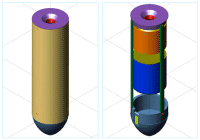Melting Probe
Completely different types of frozen worlds are icy moons in our solar system e.g. Europa, Ganymede and Callisto around Jupiter. These moons exhibit a more or less continuous ice shell with large area of disturbances indicating liquid material penetrating the hard shell at fracture zones. Especially Europa raised substantial scientific interest since the existence of a global water ocean underneath the ice shield was postulated.
Despite the high scientific value of in-situ investigation in icy layers very little effort has been spent on the carrier module (i.e. the melting probe) itself that enables sophisticated scientific instrumentation to be brought into the ice.
In general, planetary lander missions have to survive on the availability of very low resources. This concerns the mass brought to the surface, limited power provision and a low data transmission volume to the relay station or orbiter spacecraft. These constraints must be reflected in every aspect of each development step towards the breadboard model of an instrumented melting probe for planetary exploration.
Development Program
 |
|
Generic model of the melting probe prototype |
In a second phase the gained knowledge leads to the design and manufacturing of an advanced breadboard model. This model again will be subject to an extended test program.
This activity is carried out by N. Koemle and team from Institut für Weltraumforschung, Graz (Austria). The test facilities are provided by DLR Köln under the lead of J. Biele and S. Ulamec.

